The Immigrant Labour Force Analysis Series
The Canadian Immigrant Labour Market: Recent Trends from 2006 to 2017
Archived Content
Information identified as archived is provided for reference, research or recordkeeping purposes. It is not subject to the Government of Canada Web Standards and has not been altered or updated since it was archived. Please "contact us" to request a format other than those available.
By Lahouaria Yssaad and Andrew Fields
Skip to text
Text begins
Acknowledgements
This report on the Canadian immigrant labour market marks 12 years of Labour Force Survey data collection and analysis on immigrants.
The authors wish to thank all those who commented on an earlier draft of this report, including staff members of the Labour Statistics Division: Anne Milan, Emmanuelle Bourbeau, Martha Patterson, Bertrand Ouellet-Léveillé, Rachelle Pelletier, Martin Lemire, Vince Dale, Dominique Dionne-Simard, Vincent Ferrao, Marc Levesque, and Josée Bégin.
The authors are also indebted to René Houle (Social and Aboriginal Statistics Division) for his thorough review, and to Elizabeth Nash (Statistics Canada Library) for her unfailing help.
Sincere thanks go to colleagues at Immigration, Refugees and Citizenship Canada for their review of the manuscript.
Our gratitude to Alissa Souliere and Marie-Josée Major for their valuable contribution to the production and publishing stage of the report.
Last but not least, a special thank-you to Jacob Miller, from the Federal Student Work Experience Program, for his thorough and meticulous work in validating the data for the report and reviewing the final draft.
Introduction
By 2036, the share of immigrants in Canada’s population would stand between 24.5% and 30.0%, compared with 20.7% in 2011, according to the most recent demographic projections. These proportions would be the highest since 1871.Note 1
Moreover, nearly half of Canada’s populationNote 2 is projected to be made up of immigrants and second-generation individuals—that is non-immigrants with at least one parent born abroad—in 2036. This share was 38.2% in 2011.Note 3
Immigrants’ contribution to Canada’s economy and society continues, and this contributionNote 4 is expected to increase in a context of inexorable population aging. Projections show that immigration will remain a major contributor to future demographic growth. Starting in 2031, more than 80% of this growth is projected to come from immigration, compared to about 67% in 2011.Note 5 However, as many source-countries of immigrants to Canada have been facing similar trends of population aging—stemming from their own demographic transition—more nations with older populations and low birth rates will be competing with Canada for young, skilled and mobile workers.Note 6
In this context, monitoring immigrants’ labour-market outcomes is essential for understanding various aspects of their socio-economic integration. This analysis focuses on two key labour-market indicators: the rate of employment (or employment-to-population ratio) and the unemployment rate, with references to the gap between immigrants and the Canadian-born—a gap that has been extensively documented.Note 7Note 8
Using data from the Labour Force Survey (LFS), this report describes the most recent picture of immigrants’ labour-market situation, with an overview of the 12-year period since the start of the LFS series on immigrants, that is, from 2006 to 2017. The analysis focuses on core-aged landed immigrants and presents an overview of the labour-market trends for their younger and older counterparts.
Core-aged individuals are those aged 25 to 54. Individuals in this age group are most likely to have finished their schooling and to have not yet retired from the workforce (see Data source, concepts and definitions). Labour-market outcomes for core-aged people are examined by province, industry, educational attainment, socio-demographic characteristics, and place of birth. A brief analysis of immigrants’ wages is also included.
Highlights
- The lion’s share (66%) of national employment gains between 2016 and 2017 was accounted for by immigrants of core working-age (25 to 54 years) and Canadian-born workers aged 55 and older.
- The unemployment rate for core-aged immigrants edged down to 6.4% in 2017, the lowest rate since the start of the LFS immigrant series in 2006. At the same time, their employment rate rose to 78.9%, the highest rate recorded during the 12-year period. In comparison, the employment rate for the Canadian-born was 84.0% in 2017, up 0.8 percentage points from the previous year, and their unemployment rate was 5.0%, down 0.5 points.
- The employment-rate gap between immigrants and the Canadian-born narrowed for three consecutive years, after increasing in 2014. The gap in 2017 was the lowest since 2006 (start of the series). At the same time, the unemployment-rate gap was stable in 2017, but narrower than it was in 2014.
- The largest share of the immigrant employment increase from 2016 to 2017 was accounted for by those who had been in the country for more than 10 years (established immigrants). However, over one-third (35%) of this increase was attributable to very recent immigrants (in Canada for 5 years or less).
- Immigrants in British Columbia and Ontario accounted for the bulk of immigrant employment growth in 2017.
- Most of the growth in immigrant employment was in professional, scientific and technical services; finance, insurance, real estate and leasing services; manufacturing as well as health care and social assistance.
- For university-educated immigrants, employment increased between 2016 and 2017, mainly in full-time work and among those who were established (in the country for more than 10 years). For the university-educated, Canadian-born, employment also increased, pushing up their employment rate to 91.4%, the highest level since 2006. Employment gains for university-educated immigrants helped lift their employment rate to a record high of 82.1% in 2017. Consequently, the gap between them and their Canadian-born counterparts narrowed to its smallest size since 2006.
- Core-aged immigrants born in the Philippines continued to have the highest employment rate of all immigrant groups, even higher than the Canadian-born, followed by immigrants born in Europe.
- African-born immigrants had the lowest employment rate and highest unemployment rate of all immigrant groups, and these rates’ differentials with the Canadian-born were particularly high for the African-born who had been in Canada for 5 years or less.
This report uses data from the Labour Force Survey (LFS), a monthly household survey. The LFS data series on immigrants began in January 2006, when five questions were added to the questionnaire in order to identify immigrants and provide timely information on their labour market situation.
These questions are:
- In what country was ... born?
- Is…now, or has he/she ever been, a landed immigrant in Canada?
- In what year did … first become a landed immigrant?
- In what month?
- In what country did … complete his/her highest degree, certificate or diploma?
The findings in this report are based on annual averages of estimates for the years 2006 to 2017.
The concept of ‘labour-market outcomes’ covers various aspects such as wages and earnings, occupation, employment or unemployment status, participation in the labour market, hours of work, and temporary or permanent status. Earnings are also an important labour-market outcome. In this report, the term ‘labour market outcomes’ generally refers to rates of employment and unemployment. The report also includes a brief analysis of earnings data.
‘Core working-age’ refers to the ages of 25 to 54 for labour-market analysis purposes, as individuals in this age group are more likely to have completed school and be available for full-time work than those aged 15 to 24, and less likely to be retired than those 55 and older. Unless otherwise stated, the core-aged population is the main focus of the analysis found in this report.
Three groups of immigrants are identified based on how long they had been in Canada as landed immigrants prior to being interviewed for the LFS. These groups are:
- Very recent immigrants, also referred to as ‘newcomers’: Landed immigrants who had been in Canada for 5 years or less.
- Recent immigrants: Landed immigrants who had been in Canada for more than 5 to 10 years.
- Established immigrants: Landed immigrants who had been in Canada for more than 10 years.
Notes
The terms ‘immigrant’ and ‘landed immigrant’ are used in this report interchangeably.
For readability purposes, most numbers expressed in proportions are rounded. Rates of employment and unemployment as well as rates of change (increase, decrease) are presented with a decimal point.
Overview of the immigrant labour market
National employment growth driven by immigrants and older workers born in Canada
The Canadian labour market for the overall working-age population (15 years and older) recorded strong performance in 2017. Nearly 20 million individuals were in the labour force, i.e., either working or looking for work. Of this number, 18.4 million were employed—an increase of 337,000 compared with 2016. This represents an increase of 1.9%—the highest rate of growth recorded since 2013—which raised the overall employment rate to 61.6%, also the highest since 2013. At the same time, the unemployment rate fell to 6.3% in 2017, the lowest rate since 2008.
The lion’s share of employment gains between 2016 and 2017 was accounted for by immigrants of core working-age (25 to 54 years) and Canadian-born workers aged 55 and older (Table 1).
| Total, landed immigrants and born in Canada | Landed immigrants | Born in Canada | |
|---|---|---|---|
| thousands | |||
| 15 years and older | 287.2 | 115.7 | 171.5 |
| 15 to 24 years | 2.9 | -7.1 | 10.0 |
| 25 to 54 years | 145.5 | 86.8 | 58.7 |
| 55 years and older | 138.7 | 36.0 | 102.7 |
|
Note: The sum of individual categories may not always add up to the total as a result of rounding. Source: Table 14-10-0085-01 (formerly CANSIM table 282-0104). |
|||
For the core working-ages of 25 to 54, the majority (60%) of the employment gains in 2017 were accounted for by landed immigrants. This is mostly a reflection of higher population growth among immigrants compared with the Canadian-born in this age group. In contrast, among those aged 55 and older, the largest share (74%) of employment growth was attributable to the Canadian-born (Chart 1).

Data table for Chart 1
| Landed immigrants | Born in Canada | |
|---|---|---|
| percent | ||
| 15 years and older | 40.3 | 59.7 |
| 25 to 54 years | 59.7 | 40.3 |
| 55 years and older | 26.0 | 74.0 |
| Source: Table 14-10-0085-01 (formerly CANSIM table 282-0104). | ||
In 2017, over a third (34%) of employment gains among the Canadian-born were attributable to those aged 25 to 54, while the corresponding figure for immigrants was 75%. This is not surprising, as the majority of immigrants are selected in the prime working-ages of 25 to 54. This difference between immigrants and the Canadian-born in the core-aged group highlights the well-known demographic trend of the aging of the baby-boom generation.
As the share of the labour force born in Canada declined steadily (from 78% in 2006 to 74% in 2017), the share of immigrants has increased (from 22% to 26% during the same period). This is reflected in the long-term trend of employment (Chart 2), indicating how immigrants’ growing contribution to Canada’s economy and society is associated with long-term demographic trends that are prevalent in most industrialized countries.

Data table for Chart 2
| Year | Population, landed immigrants | Employment, landed immigrants | Population, born in Canada | Employment, born in Canada |
|---|---|---|---|---|
| 2006 = 100 | ||||
| 2006 | 100.00 | 100.00 | 100.00 | 100.00 |
| 2007 | 101.56 | 101.87 | 100.37 | 101.24 |
| 2008 | 102.81 | 102.51 | 100.63 | 101.85 |
| 2009 | 104.22 | 100.59 | 100.91 | 99.78 |
| 2010 | 105.90 | 102.53 | 100.91 | 100.06 |
| 2011 | 109.75 | 106.89 | 99.90 | 99.71 |
| 2012 | 111.93 | 110.66 | 99.28 | 99.45 |
| 2013 | 115.33 | 114.62 | 98.36 | 98.70 |
| 2014 | 117.42 | 115.65 | 98.16 | 98.26 |
| 2015 | 120.88 | 119.91 | 97.62 | 97.93 |
| 2016 | 127.00 | 126.88 | 96.19 | 96.41 |
| 2017 | 128.56 | 130.51 | 95.95 | 97.06 |
| Source: Table 14-10-0085-01 (formerly CANSIM table 282-0104). | ||||
Immigrants’ employment rate increases slightly
In 2017, employment for core-aged immigrants edged up from the previous year, and the unemployment rate fell slightly (-0.5 percentage points) to 6.4%. At the same time, their employment rate rose by 1.3 percentage points to 78.9%. The unemployment and employment rates for their Canadian-born counterparts were 5.0% and 84.0% respectively. Immigrants’ employment rate in 2017 was the highest since the start of the LFS immigrant data series in 2006.
However, the employment-rate gap between immigrants and the Canadian-born has remained relatively stable (Chart 3). As shown in Chart 2, the employment and population of immigrants grew at a similar pace. Population and employment also followed a similar trend among the Canadian-born.
Time since landing is a major determinant of immigrants’ labour-market performance. In particular, very recent immigrants (who have been in the country for five years or less) face a number of hurdles in the labour market, such as a lack of language proficiency, lack of recognition of foreign credentials, inadequate familiarity with the Canadian labour market, as well as other challengesNote 9 (see Very recent immigrants, 2006 to 2017).
Newcomers (very recent immigrants) have historically had lower employment rates compared with other landed immigrant groups. Established immigrants (those who landed more than 10 years earlier) are more likely to see their labour-market outcomes converge toward those of the Canadian-born (Chart 3).
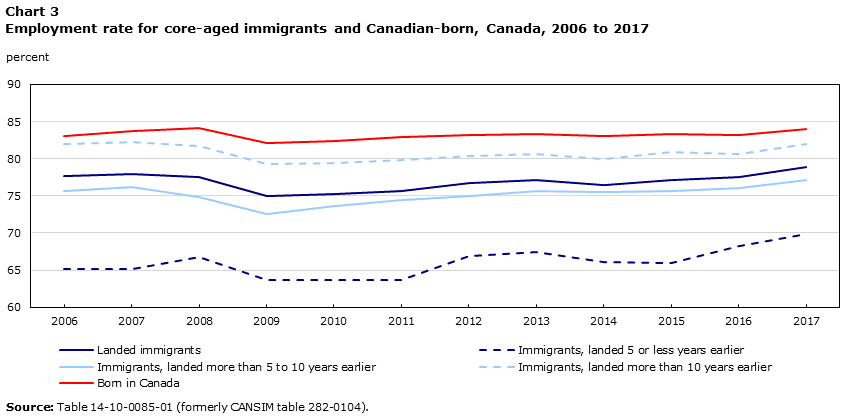
Data table for Chart 3
| Year | Landed immigrants | Immigrants, landed 5 or less years earlier | Immigrants, landed more than 5 to 10 years earlier | Immigrants, landed more than 10 years earlier | Born in Canada |
|---|---|---|---|---|---|
| percent | |||||
| 2006 | 77.7 | 65.2 | 75.6 | 82.0 | 83.1 |
| 2007 | 77.9 | 65.1 | 76.2 | 82.2 | 83.8 |
| 2008 | 77.5 | 66.7 | 74.8 | 81.7 | 84.1 |
| 2009 | 75.0 | 63.6 | 72.5 | 79.3 | 82.1 |
| 2010 | 75.2 | 63.6 | 73.7 | 79.4 | 82.4 |
| 2011 | 75.7 | 63.6 | 74.5 | 79.8 | 82.9 |
| 2012 | 76.8 | 66.9 | 75.0 | 80.4 | 83.2 |
| 2013 | 77.2 | 67.4 | 75.7 | 80.6 | 83.3 |
| 2014 | 76.5 | 66.1 | 75.5 | 79.9 | 83.1 |
| 2015 | 77.1 | 66.0 | 75.6 | 80.9 | 83.3 |
| 2016 | 77.6 | 68.2 | 76.1 | 80.7 | 83.2 |
| 2017 | 78.9 | 69.8 | 77.2 | 82.0 | 84.0 |
| Source: Table 14-10-0085-01 (formerly CANSIM table 282-0104). | |||||
While the employment rate for newcomers was 69.8% in 2017, only slightly up from the rate observed in 2016, it was higher than it had ever been during the 12-year period of the LFS immigrant data series. The gap of 14.2 percentage points between newcomers and the Canadian-born was little changed in 2017 from a year earlier, though it narrowed compared with 2006, when the employment rate for very recent immigrants was 17.9 percentage points below the rate for the Canadian-born.
For recent immigrants—those who landed more than 5 to 10 years earlier—the employment rate also rose slightly to 77.2%, and the gap with the Canadian-born edged down to 6.8 percentage points in 2017 (versus a gap of 7.1 points in 2016 and 7.5 in 2006).
As for established immigrants (those who landed more than 10 years earlier), they tend to fare better in the labour market as they converge closer to the Canadian-born, with an employment rate of 82.0% in 2017, up 1.3 percentage points from the year before. However, as the employment rate for the Canadian-born (84.0%) also increased notably, the gap between the two groups remained significant, at 2.0 percentage points in 2017, though this gap narrowed slightly from 2016—when it stood at 2.5 percentage points.
Start of text boxTime since landing: Social and economic integration of immigrants is a process that takes some time. But how long does it take for immigrants’ labour-market outcomes to converge with those of the Canadian-born? A number of factors influence the process and likelihood of convergence, including knowledge of English or French, level and country of education, recognition of foreign credentials, and presence of social networks in Canada. Hence, time since landing is a key determinant of immigrants’ labour market outcomes, and the labour-force data show this clearly. Although it does not disappear, the gap between immigrants and the Canadian-born narrows based on time since landing (Table 2).
| Employment rate | Employment-rate gapTable 2 Note 1 | Unemployment rate | Unemployment-rate gapTable 2 Note 1 | |
|---|---|---|---|---|
| percent | percentage points | percent | percentage points | |
| Immigrants, landed 5 or less years earlier | 69.8 | 14.2Note * | 9.6 | 4.6Note * |
| Immigrants, landed more than 5 to 10 years earlier | 77.2 | 6.8Note * | 6.2 | 1.2Note * |
| Immigrants, landed more than 10 years earlier | 82.0 | 2.0Note * | 5.6 | 0.6Note * |
| Born in Canada (reference category) | 84.0 | Note ...: not applicable | 5.0 | Note ...: not applicable |
... not applicable
|
||||
Newcomers’ unemployment rate lowest since 2006
The unemployment rate for core-aged immigrants was 6.4% in 2017, the lowest rate since 2006—when comparable data became available. All immigrant groups saw a decline in their rate of unemployment, especially very recent immigrants (newcomers), whose rate (9.6%) stood below the double digits for the first time since 2006 (Chart 4).

Data table for Chart 4
| Year | Landed immigrants | Immigrants, landed 5 or less years earlier | Immigrants, landed more than 5 to 10 years earlier | Immigrants, landed more than 10 years earlier | Born in Canada |
|---|---|---|---|---|---|
| percent | |||||
| 2006 | 6.5 | 11.5 | 7.3 | 5.1 | 4.9 |
| 2007 | 6.6 | 11.1 | 7.4 | 5.3 | 4.6 |
| 2008 | 6.8 | 10.9 | 7.4 | 5.4 | 4.6 |
| 2009 | 9.6 | 14.3 | 10.9 | 8.0 | 6.4 |
| 2010 | 9.5 | 14.7 | 9.7 | 8.0 | 6.2 |
| 2011 | 8.5 | 13.3 | 7.9 | 7.3 | 5.6 |
| 2012 | 7.9 | 11.9 | 8.7 | 6.6 | 5.4 |
| 2013 | 7.6 | 11.0 | 7.8 | 6.6 | 5.3 |
| 2014 | 7.4 | 11.5 | 7.4 | 6.3 | 5.2 |
| 2015 | 6.9 | 10.9 | 8.0 | 5.6 | 5.4 |
| 2016 | 6.9 | 10.2 | 7.7 | 5.9 | 5.5 |
| 2017 | 6.4 | 9.6 | 6.2 | 5.6 | 5.0 |
| Source: Table 14-10-0085-01 (formerly CANSIM table 282-0104). | |||||
Within the core-aged group, the unemployment-rate gap between immigrants and the Canadian-born was little changed overall. For established immigrants, however, the gap widened in 2017 after being negligible in 2016. This can be explained by the unemployment rate declining faster for the Canadian-born (from 5.5% to 5.0%) than for established immigrants (from 5.9% to 5.6%).
Recent immigrants (who landed between 5 and 10 years earlier) were the only group with a notable decline in their unemployment rate, from 7.7% in 2016 to 6.2% in 2017, while their employment rate was slightly up to 77.2%.
Immigrant labour-market outcomes by province
Higher employment rates in Western Canada
While landed immigrants made up 26% of Canada’s core-aged workforce, they accounted for more than half (52%) of the employment increase from 2016 to 2017. The bulk of this increase was attributable to immigrants in British Columbia and Ontario.
Despite little change in its labour force, Manitoba remains one of the provinces with the smallest gaps in labour-market outcomes between immigrants and the Canadian-born within the core-aged group. In 2017, the employment rate of immigrants in Manitoba was the highest (83.1%) among immigrants of all provinces (Chart 5). Furthermore, established immigrants were more likely to be employed than the Canadian-born (85.8% versus 83.9%) and slightly less likely to be unemployed (3.9% versus 4.0% respectively). Also, newcomers in Manitoba had an employment rate of 76.2%, the second highest after Alberta (78.0%).
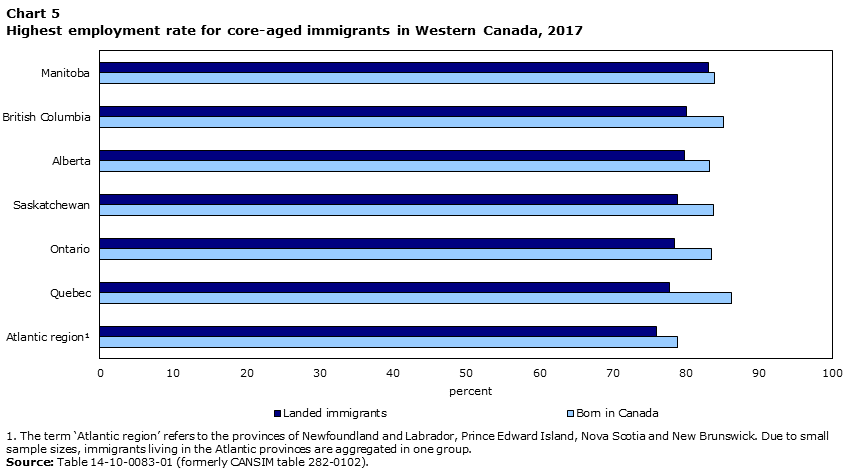
Data table for Chart 5
| Landed immigrants | Born in Canada | |
|---|---|---|
| percent | ||
| Manitoba | 83.1 | 83.9 |
| British Columbia | 80.1 | 85.2 |
| Alberta | 79.8 | 83.2 |
| Saskatchewan | 78.9 | 83.8 |
| Ontario | 78.4 | 83.5 |
| Quebec | 77.8 | 86.2 |
| Atlantic regionChart 5 Note 1 | 76.0 | 78.9 |
|
||
British Columbia had notable positive employment trends in 2017, with overall employment growth of 3.7%, higher than the national average of 1.9%. Among core-aged individuals, those born in Canada saw a notable increase (+2.6 percentage points) in their employment rate, which rose to 85.2%, while the rate for immigrants edged up (+1.5 percentage points) to 80.1%—the highest rate since 2006 (Chart 6).
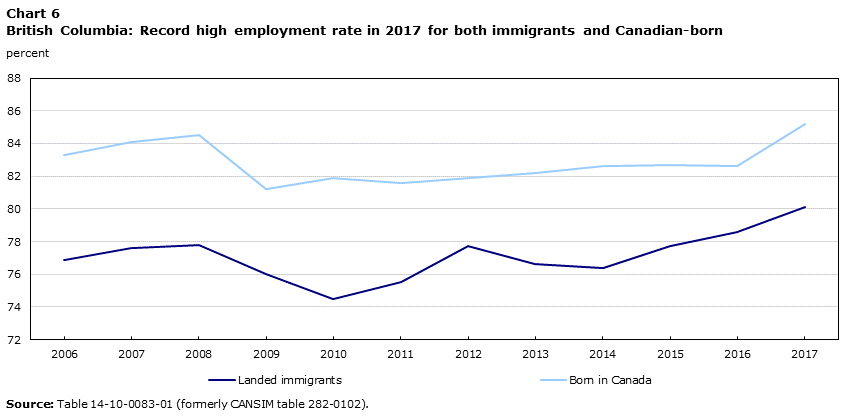
Data table for Chart 6
| Year | Landed immigrants | Born in Canada |
|---|---|---|
| percent | ||
| 2006 | 76.9 | 83.3 |
| 2007 | 77.6 | 84.1 |
| 2008 | 77.8 | 84.5 |
| 2009 | 76.0 | 81.2 |
| 2010 | 74.5 | 81.9 |
| 2011 | 75.5 | 81.6 |
| 2012 | 77.7 | 81.9 |
| 2013 | 76.6 | 82.2 |
| 2014 | 76.4 | 82.6 |
| 2015 | 77.7 | 82.7 |
| 2016 | 78.6 | 82.6 |
| 2017 | 80.1 | 85.2 |
| Source: Table 14-10-0083-01 (formerly CANSIM table 282-0102). | ||
At the same time, immigrants’ unemployment rate edged down to 4.7%, compared to 4.2% for the Canadian-born (Chart 7). Newcomers’ employment rate of 71.8% was up slightly from 2016, while their unemployment rate (7.3% in 2017) was the lowest since 2006. As for core-aged established immigrants, they fared just as well as the Canadian-born, with an unemployment rate of 4.2% in 2017.
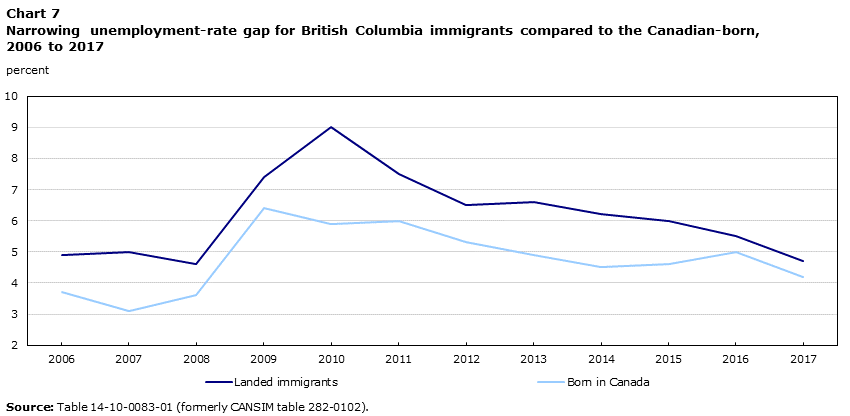
Data table for Chart 7
| Year | Landed immigrants | Born in Canada |
|---|---|---|
| percent | ||
| 2006 | 4.9 | 3.7 |
| 2007 | 5.0 | 3.1 |
| 2008 | 4.6 | 3.6 |
| 2009 | 7.4 | 6.4 |
| 2010 | 9.0 | 5.9 |
| 2011 | 7.5 | 6.0 |
| 2012 | 6.5 | 5.3 |
| 2013 | 6.6 | 4.9 |
| 2014 | 6.2 | 4.5 |
| 2015 | 6.0 | 4.6 |
| 2016 | 5.5 | 5.0 |
| 2017 | 4.7 | 4.2 |
| Source: Table 14-10-0083-01 (formerly CANSIM table 282-0102). | ||
Some of the narrower gaps between core-aged immigrants and Canadian-born were also found in Alberta, where the immigrant employment rate was the third highest among the provinces in 2017, at 79.8%.
In 2014, the rate of employment in the province started to slide for both immigrants and the Canadian-born—coinciding with economic weakness due to falling oil prices—and hit record lows in 2016, before moving upwards in 2017 (Chart 8).
The impact of the falling oil prices was also reflected in the unemployment rate, which increased to 7.7% for immigrants in 2017 (up from 5.2% in 2014) and 6.3% for the Canadian-born (up from 3.4%). Alberta’s very recent immigrants have historically had one of the narrowest employment-rate gaps with the Canadian-born—5.2 percentage points in 2017, compared to 14.2 points for Canada as a whole.

Data table for Chart 8
| Year | Landed immigrants | Born in Canada |
|---|---|---|
| percent | ||
| 2006 | 81.7 | 86.5 |
| 2007 | 82.7 | 87.0 |
| 2008 | 82.0 | 86.9 |
| 2009 | 80.7 | 84.0 |
| 2010 | 80.2 | 83.0 |
| 2011 | 82.2 | 84.3 |
| 2012 | 82.4 | 85.3 |
| 2013 | 82.1 | 84.8 |
| 2014 | 81.7 | 85.0 |
| 2015 | 80.2 | 84.0 |
| 2016 | 77.9 | 82.8 |
| 2017 | 79.8 | 83.2 |
| Source: Table 14-10-0083-01 (formerly CANSIM table 282-0102). | ||
Following a decade of steady growth, overall employment in Saskatchewan was little changed in 2017. The employment rate for the province’s immigrants fell to 78.9% (down 3.6 percentage points from 2016). This was the largest decline since 2006, widening the gap between them and the Canadian-born (Chart 9). At the same time, immigrants’ unemployment rate edged up from 5.9% to 7.1%. While landed immigrants made up nearly 14% of Saskatchewan's total labour force in 2017, this proportion is almost triple the figure in 2006.
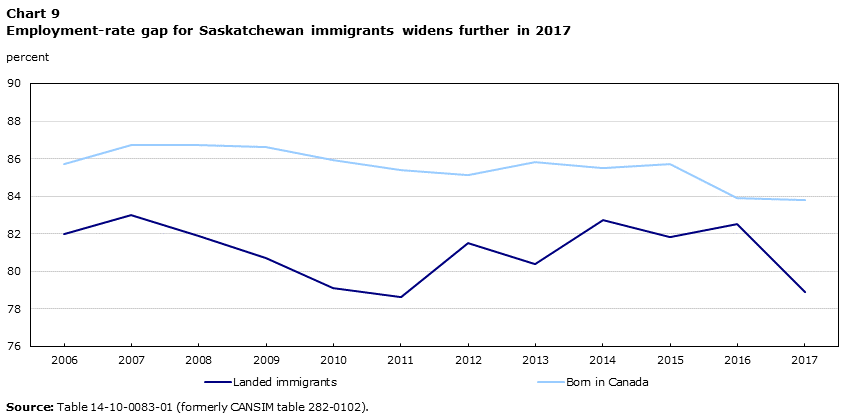
Data table for Chart 9
| Year | Landed immigrants | Born in Canada |
|---|---|---|
| percent | ||
| 2006 | 82.0 | 85.7 |
| 2007 | 83.0 | 86.7 |
| 2008 | 81.9 | 86.7 |
| 2009 | 80.7 | 86.6 |
| 2010 | 79.1 | 85.9 |
| 2011 | 78.6 | 85.4 |
| 2012 | 81.5 | 85.1 |
| 2013 | 80.4 | 85.8 |
| 2014 | 82.7 | 85.5 |
| 2015 | 81.8 | 85.7 |
| 2016 | 82.5 | 83.9 |
| 2017 | 78.9 | 83.8 |
| Source: Table 14-10-0083-01 (formerly CANSIM table 282-0102). | ||
In the province of Ontario—home to half of Canada’s core-aged immigrant population in 2017—employment for immigrants held steady, and their employment rate was 78.4%. The unemployment rate for this group was 5.8%, slightly down from 2016, and at its lowest level since comparable data became available in 2006.
The unemployment rate for very recent immigrants in Ontario dropped below the double-digits for the first time in 12 years, falling to 9.3% in 2017 (Chart 10). As for the Canadian-born, employment was little changed in 2017 and the employment rate stood at 83.5%, the same as in 2016, while their unemployment rate was 4.5%.

Data table for Chart 10
| Year | Immigrants, landed 5 or less years earlier | Immigrants, landed more than 5 to 10 years earlier | Immigrants, landed more than 10 years earlier | Born in Canada |
|---|---|---|---|---|
| percent | ||||
| 2006 | 11.1 | 7.0 | 5.0 | 4.4 |
| 2007 | 11.9 | 7.6 | 5.4 | 4.4 |
| 2008 | 11.4 | 7.7 | 5.9 | 4.4 |
| 2009 | 15.3 | 12.2 | 8.8 | 6.7 |
| 2010 | 17.0 | 9.8 | 8.4 | 6.2 |
| 2011 | 14.5 | 8.1 | 7.8 | 5.5 |
| 2012 | 12.7 | 8.7 | 7.0 | 5.6 |
| 2013 | 13.0 | 8.2 | 6.7 | 5.5 |
| 2014 | 12.5 | 9.0 | 6.2 | 5.1 |
| 2015 | 10.1 | 8.0 | 5.3 | 5.1 |
| 2016 | 11.2 | 7.8 | 5.2 | 4.8 |
| 2017 | 9.3 | 6.3 | 5.1 | 4.5 |
| Source: Table 14-10-0083-01 (formerly CANSIM table 282-0102). | ||||
In Quebec, overall labour-market indicators (that is, for the population aged 15 and older) improved noticeably in the last few years, with the employment rate rising to a record high of 60.9% in 2017, and the unemployment rate falling to 6.1%—the lowest rate in four decades. The unemployment rate was also lower than the Canadian average of 6.3%.
For the province’s core-aged immigrants, the employment rate edged up to 77.8% in 2017, the highest rate since 2006 (Chart 11). All immigrant groups of core working-age (very recent, recent, and established) showed a slight increase in their employment rates between 2016 and 2017. At the same time, the Canadian-born saw their employment rate rise to a record high of 86.2% in 2017 (up 1.4 percentage points from 2016).

Data table for Chart 11
| Year | Landed immigrants | Immigrants, landed 5 or less years earlier | Immigrants, landed more than 5 to 10 years earlier | Immigrants, landed more than 10 years earlier | Born in Canada |
|---|---|---|---|---|---|
| percent | |||||
| 2006 | 71.0 | 58.9 | 71.7 | 76.6 | 81.8 |
| 2007 | 72.1 | 57.8 | 71.9 | 78.6 | 83.1 |
| 2008 | 72.7 | 59.5 | 73.5 | 79.1 | 83.1 |
| 2009 | 69.9 | 53.5 | 71.7 | 77.1 | 82.2 |
| 2010 | 71.2 | 56.7 | 73.3 | 77.6 | 82.8 |
| 2011 | 70.5 | 57.7 | 75.4 | 75.6 | 83.3 |
| 2012 | 72.2 | 57.3 | 71.8 | 80.2 | 83.9 |
| 2013 | 72.9 | 62.7 | 73.2 | 78.0 | 84.0 |
| 2014 | 72.3 | 57.9 | 76.2 | 78.0 | 83.5 |
| 2015 | 72.8 | 58.7 | 74.8 | 79.1 | 84.5 |
| 2016 | 76.0 | 63.8 | 77.2 | 80.5 | 84.8 |
| 2017 | 77.8 | 65.8 | 79.6 | 81.9 | 86.2 |
| Source: Table 14-10-0083-01 (formerly CANSIM table 282-0102). | |||||
As for the unemployment rate, it edged down for immigrants to 8.7% in 2017 (from 9.0% the previous year). Moreover, the rate in 2017 was at its lowest level since 2006 (Chart 12). For the Canadian-born, the unemployment rate fell to 4.5% (˗0.8 percentage points from 2016).
Compared to core-aged immigrants in the other provinces, those in Quebec have historically had higher unemployment rates—particularly very recent immigrants, whose rate was 14.1% in 2017, higher than the rates in the other provinces (Chart 12). The Canadian average was 9.6% (Table 3).
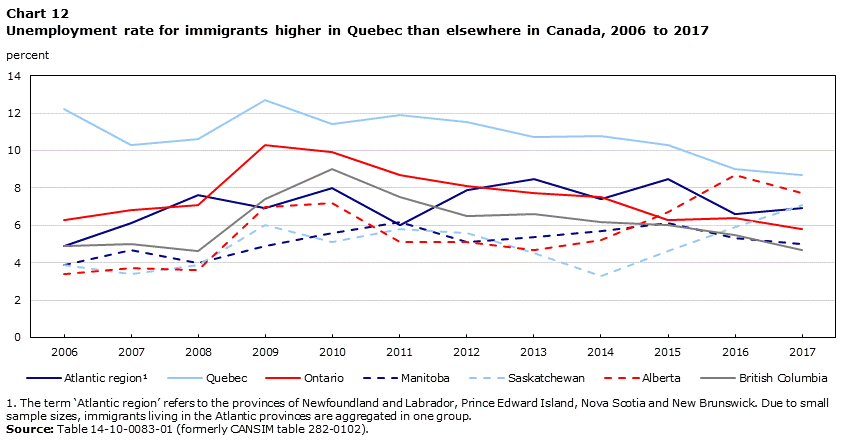
Data table for Chart 12
| Year | Atlantic regionChart 12 Note 1 | Quebec | Ontario | Manitoba | Saskatchewan | Alberta | British Columbia |
|---|---|---|---|---|---|---|---|
| percent | |||||||
| 2006 | 4.9 | 12.2 | 6.3 | 3.9 | 3.9 | 3.4 | 4.9 |
| 2007 | 6.1 | 10.3 | 6.8 | 4.7 | 3.4 | 3.7 | 5.0 |
| 2008 | 7.6 | 10.6 | 7.1 | 4.0 | 3.9 | 3.6 | 4.6 |
| 2009 | 6.9 | 12.7 | 10.3 | 4.9 | 6.0 | 7.0 | 7.4 |
| 2010 | 8.0 | 11.4 | 9.9 | 5.6 | 5.1 | 7.2 | 9.0 |
| 2011 | 6.0 | 11.9 | 8.7 | 6.2 | 5.8 | 5.1 | 7.5 |
| 2012 | 7.9 | 11.5 | 8.1 | 5.1 | 5.6 | 5.1 | 6.5 |
| 2013 | 8.5 | 10.7 | 7.7 | 5.4 | 4.5 | 4.7 | 6.6 |
| 2014 | 7.4 | 10.8 | 7.5 | 5.7 | 3.3 | 5.2 | 6.2 |
| 2015 | 8.5 | 10.3 | 6.3 | 6.1 | 4.6 | 6.7 | 6.0 |
| 2016 | 6.6 | 9.0 | 6.4 | 5.3 | 5.9 | 8.7 | 5.5 |
| 2017 | 6.9 | 8.7 | 5.8 | 5.0 | 7.1 | 7.7 | 4.7 |
|
|||||||
| Both sexes | Men | Women | |
|---|---|---|---|
| percent | |||
| Canada | 9.6 | 6.9 | 12.8 |
| Atlantic regionTable 3 Note 1 | 7.8 | 8.1 | 9.4 |
| Quebec | 14.1 | 9.0 | 20.5 |
| Ontario | 9.3 | 7.1 | 11.9 |
| Manitoba | 8.1 | 6.0 | 10.6 |
| Saskatchewan | 8.0 | 6.7 | 9.6 |
| Alberta | 7.9 | 5.0 | 11.0 |
| British Columbia | 7.3 | 5.9 | 8.9 |
|
|||
Immigrant employment changes by industry
Significant growth in professional, scientific and technical services
In 2017, over one in ten core-aged immigrants (10.9%) worked in professional, scientific and technical services. Also, immigrants’ employment in this industry grew by 10.0% from the previous year. In contrast, close to 8% of the Canadian-born were employed in this industry and their employment growth was little changed.
Employment growth in professional, scientific and technical services was split between very recent immigrants and established immigrants.
Professional, scientific and technical services include subsectors such as legal services, accounting, architectural, engineering and related services, computer systems designs, management, scientific and technical consulting, as well as scientific research and development. This is one of the higher paid industries, and much of the expertise in it requires university or college education. In 2017, virtually half of employed immigrants aged 25 to 54 had university degrees (49.7%), while less than a third (about 31%) of the Canadian-born did.
Among immigrants of working age (15 or older), employment in professional, scientific and technical services has been on an upward trend in recent years, increasing at a faster pace than total employment (Chart 13).
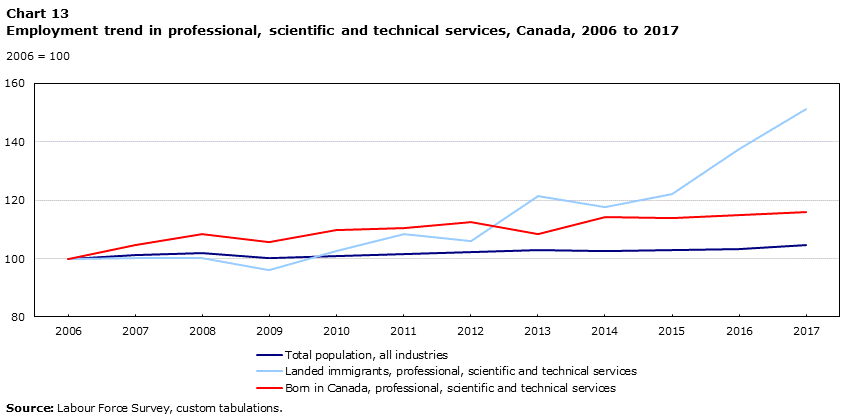
Data table for Chart 13
| Year | Total population, all industries | Landed immigrants, professional, scientific and technical services | Born in Canada, professional, scientific and technical services |
|---|---|---|---|
| 2006 = 100 | |||
| 2006 | 100.00 | 100.00 | 100.00 |
| 2007 | 101.28 | 100.04 | 104.51 |
| 2008 | 101.95 | 100.27 | 108.48 |
| 2009 | 100.07 | 96.16 | 105.61 |
| 2010 | 100.73 | 102.55 | 109.91 |
| 2011 | 101.57 | 108.31 | 110.45 |
| 2012 | 102.35 | 106.17 | 112.42 |
| 2013 | 102.85 | 121.36 | 108.57 |
| 2014 | 102.68 | 117.61 | 114.08 |
| 2015 | 103.08 | 121.98 | 114.03 |
| 2016 | 103.34 | 137.58 | 115.06 |
| 2017 | 104.78 | 151.30 | 115.96 |
| Source: Labour Force Survey, custom tabulations. | |||
Finance, insurance, real estate, rental and leasing is another industry where immigrants’ share of total employment is higher than that of the Canadian-born (9.0% versus 6.2% respectively). Between 2016 and 2017, employment in this industry edged up for core-aged immigrants, while it was little changed for the Canadian-born. The same was true for two other major employment industries in the Canadian economy: manufacturing as well as health care and social assistance (see Immigrants’ industrial profile).
Start of text boxLooking at their employment distribution, immigrants are more likely to work in some industries. While they made up 26% of overall employment, their share in accommodation and food industries was 35%. According to data from the Survey of Employment, Payrolls and Hours, average weekly earnings in this industry are lower than in any other industry: $383.33 in 2017 compared to an industrial aggregate of $976.14.
Immigrants are also more likely to be employed in other, high-paying industries such as finance, insurance, real estate, rental and leasing services, as well as professional, scientific and technical services—where their share was 34% and 32% respectively. In contrast, 16% of workers in public administration were immigrants (Chart 14).

Data table for Chart 14
| Proportion | |
|---|---|
| percent | |
| Accommodation and food services | 34.7 |
| Finance, insurance, real estate and leasing | 33.7 |
| Transportation and warehousing | 32.5 |
| Professional, scientific and technical services | 32.0 |
| Manufacturing | 31.6 |
| Business, building and other support services | 30.3 |
| Other services | 26.4 |
| All industries | 25.8 |
| Health care and social assistance | 25.5 |
| Wholesale and retail trade | 25.4 |
| Construction | 19.0 |
| Educational services | 17.1 |
| Public administration | 15.7 |
|
|
Immigrant labour-market outcomes by socio-demographic characteristics
Immigrant men narrowing the gap with their Canadian-born counterparts
For the first time in 2017, the unemployment rate for core-aged immigrant men and the Canadian-born was the same, at 5.6%. Indeed, for men who were recent immigrants (landed 5 to 10 years earlier), the unemployment rate (4.8%) was lower than it was for the Canadian-born. The gap had been already virtually non-existent in 2015, as it had narrowed notably for all immigrant groups, including newcomers (in the country for 5 years or less), for whom the unemployment-rate gap fell from 5.1 percentage points in 2006 to 1.3 percentage points in 2017 (Chart 15 and Table 4).
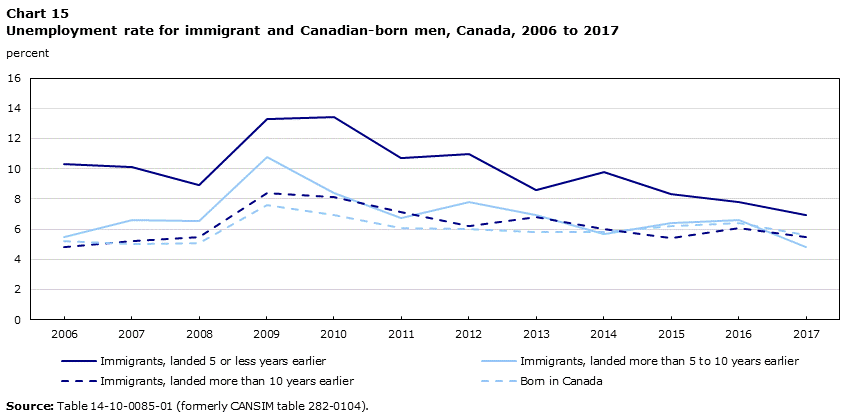
Data table for Chart 15
| Year | Immigrants, landed 5 or less years earlier | Immigrants, landed more than 5 to 10 years earlier | Immigrants, landed more than 10 years earlier | Born in Canada |
|---|---|---|---|---|
| percent | ||||
| 2006 | 10.3 | 5.5 | 4.8 | 5.2 |
| 2007 | 10.1 | 6.6 | 5.2 | 5.0 |
| 2008 | 8.9 | 6.5 | 5.5 | 5.1 |
| 2009 | 13.3 | 10.8 | 8.4 | 7.6 |
| 2010 | 13.4 | 8.4 | 8.1 | 6.9 |
| 2011 | 10.7 | 6.7 | 7.1 | 6.1 |
| 2012 | 11.0 | 7.8 | 6.2 | 6.0 |
| 2013 | 8.6 | 6.9 | 6.8 | 5.8 |
| 2014 | 9.8 | 5.7 | 6.0 | 5.8 |
| 2015 | 8.3 | 6.4 | 5.4 | 6.2 |
| 2016 | 7.8 | 6.6 | 6.1 | 6.4 |
| 2017 | 6.9 | 4.8 | 5.5 | 5.6 |
| Source: Table 14-10-0085-01 (formerly CANSIM table 282-0104). | ||||
Also, the employment rate for all core-aged immigrant men, at 86.5% in 2017, was not significantly different from the rate of their Canadian-born counterparts (86.0%). In fact, it was significantly higher for recent and established immigrants (Table 4).
| Unemployment rate | Employment rate | |||
|---|---|---|---|---|
| 2016 | 2017 | 2016 | 2017 | |
| percent | ||||
| Men | ||||
| Landed immigrants | 6.5 | 5.6 | 85.6 | 86.5 |
| Immigrants, landed 5 or less years earlier | 7.8Note * | 6.9 | 81.5Note * | 82.2Note * |
| Immigrants, landed more than 5 to 10 years earlier | 6.6 | 4.8 | 85.8 | 88.2Note * |
| Immigrants, landed more than 10 years earlier | 6.1 | 5.5 | 86.6Note * | 87.3Note * |
| Born in Canada (reference category) | 6.4 | 5.6 | 85.2 | 86.0 |
| Women | ||||
| Landed immigrants | 7.4Note * | 7.2Note * | 70.5Note * | 72.0Note * |
| Immigrants, landed 5 or less years earlier | 13.1Note * | 12.8Note * | 56.5Note * | 58.5Note * |
| Immigrants, landed more than 5 to 10 years earlier | 8.9Note * | 7.7Note * | 67.6Note * | 67.5Note * |
| Immigrants, landed more than 10 years earlier | 5.6Note * | 5.7Note * | 75.3Note * | 77.2Note * |
| Born in Canada (reference category) | 4.5 | 4.3 | 81.2 | 82.0 |
|
||||
Wider gaps typical for immigrant women
Gaps in labour-market outcomes are typically wider for core-aged immigrant women, both as compared with their male counterparts and with Canadian-born women. For example, as shown in Table 4, the employment rate for immigrant women is much lower than that of their Canadian-born counterparts (72.0% versus 82.0% in 2017), and their unemployment rate almost double (7.2% versus 4.3%). Immigrant women are more likely to face persistent challenges becoming employed.Note 10
For female newcomers, in particular, the unemployment-rate gap (with Canadian-born women) was large: 8.5 percentage points in 2017, unchanged from the gap observed in 2006 (Chart 16).
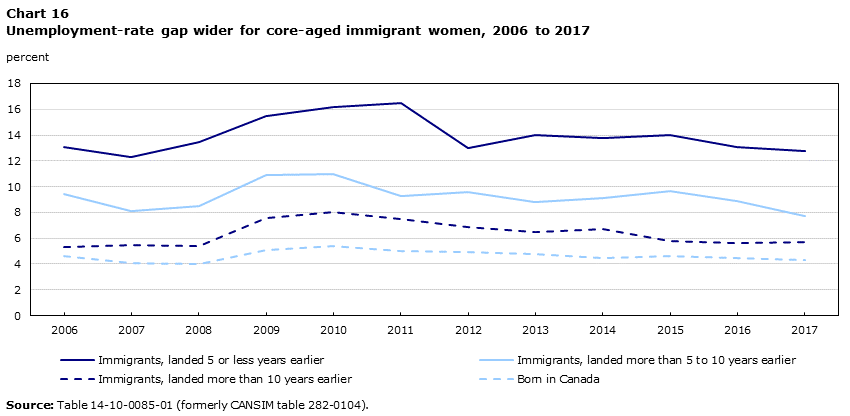
Data table for Chart 16
| Year | Immigrants, landed 5 or less years earlier | Immigrants, landed more than 5 to 10 years earlier | Immigrants, landed more than 10 years earlier | Born in Canada |
|---|---|---|---|---|
| percent | ||||
| 2006 | 13.1 | 9.4 | 5.3 | 4.6 |
| 2007 | 12.3 | 8.1 | 5.5 | 4.1 |
| 2008 | 13.5 | 8.5 | 5.4 | 4.0 |
| 2009 | 15.5 | 10.9 | 7.6 | 5.1 |
| 2010 | 16.2 | 11.0 | 8.0 | 5.4 |
| 2011 | 16.5 | 9.3 | 7.5 | 5.0 |
| 2012 | 13.0 | 9.6 | 6.9 | 4.9 |
| 2013 | 14.0 | 8.8 | 6.5 | 4.8 |
| 2014 | 13.8 | 9.1 | 6.7 | 4.5 |
| 2015 | 14.0 | 9.7 | 5.8 | 4.6 |
| 2016 | 13.1 | 8.9 | 5.6 | 4.5 |
| 2017 | 12.8 | 7.7 | 5.7 | 4.3 |
| Source: Table 14-10-0085-01 (formerly CANSIM table 282-0104). | ||||
Immigrant youth unemployment rate: Gap narrowing slightly
Immigrant youth aged 15 to 24 saw little change in their rates of employment (47.9%) and unemployment (13.2%) in 2017 compared with the previous year, while their Canadian-born counterparts experienced an increase of 1.3 percentage points in their employment rate, which rose to 58.8%, and a decline of the same magnitude in their unemployment rate, which fell to 11.4% (Chart 17).

Data table for Chart 17
| Year | Landed immigrants | Born in Canada |
|---|---|---|
| percent | ||
| 2006 | 14.7 | 11.3 |
| 2007 | 14.8 | 10.7 |
| 2008 | 14.2 | 11.3 |
| 2009 | 20.3 | 14.8 |
| 2010 | 19.2 | 14.4 |
| 2011 | 16.5 | 14.0 |
| 2012 | 16.7 | 14.1 |
| 2013 | 16.7 | 13.4 |
| 2014 | 17.2 | 13.0 |
| 2015 | 14.8 | 13.0 |
| 2016 | 14.7 | 12.7 |
| 2017 | 13.2 | 11.4 |
| Source: Table 14-10-0085-01 (formerly CANSIM table 282-0104). | ||
For immigrant youth as a whole, the unemployment-rate gap (1.8 percentage points) remained significant compared with their Canadian-born counterparts, but this gap has narrowed gradually in recent years, as the unemployment rate for immigrant youth fell from a recent high of 17.2% in 2014 to an unprecedented low of 13.2% in 2017.
Similarly, the employment rate for immigrant youth—though significantly lower than the rate for the Canadian-born—advanced by 3.5 percentage points from 2014 to 2017, while the rate for youth born in Canada rose by 0.8 percentage points. Most of the increase in the employment rate for immigrants aged 15 to 24 was attributable to those who were newcomers (Chart 18).
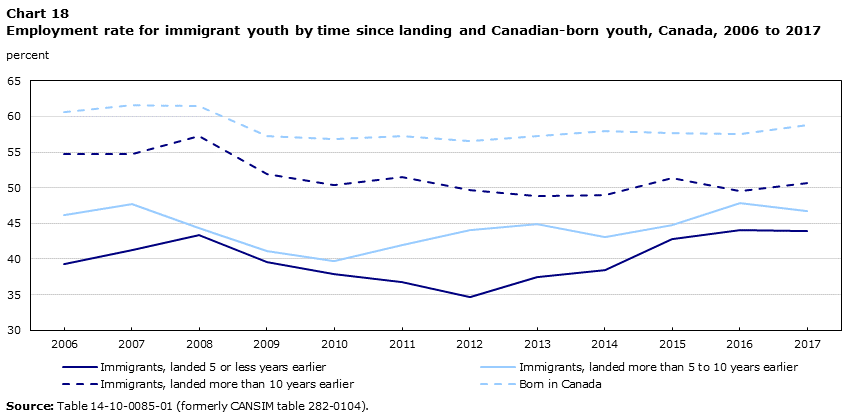
Data table for Chart 18
| Year | Immigrants, landed 5 or less years earlier | Immigrants, landed more than 5 to 10 years earlier | Immigrants, landed more than 10 years earlier | Born in Canada |
|---|---|---|---|---|
| percent | ||||
| 2006 | 39.3 | 46.2 | 54.7 | 60.6 |
| 2007 | 41.2 | 47.7 | 54.7 | 61.6 |
| 2008 | 43.4 | 44.4 | 57.3 | 61.4 |
| 2009 | 39.6 | 41.1 | 51.9 | 57.2 |
| 2010 | 37.9 | 39.7 | 50.4 | 56.9 |
| 2011 | 36.8 | 41.9 | 51.5 | 57.3 |
| 2012 | 34.7 | 44.1 | 49.7 | 56.5 |
| 2013 | 37.4 | 44.9 | 48.8 | 57.2 |
| 2014 | 38.5 | 43.1 | 49.0 | 58.0 |
| 2015 | 42.8 | 44.8 | 51.4 | 57.7 |
| 2016 | 44.0 | 47.9 | 49.6 | 57.5 |
| 2017 | 43.9 | 46.7 | 50.6 | 58.8 |
| Source: Table 14-10-0085-01 (formerly CANSIM table 282-0104). | ||||
Older immigrants’ rate of employment up slightly
The level of employment among immigrants aged 55 and older edged up by 3.6% in 2017 compared with the previous year. As a result, their employment rate rose slightly (+0.7 percentage points) to 35.2%, while their unemployment rate fell to 5.8% (down from 6.8% in 2016).
At the same time, employment among their Canadian-born counterparts rose by 3.8%, matching the pace of growth (+3.4%) in their population (see Population of older workers still growing). As a result, their employment rate held steady at 35.9%, while their unemployment rate was little changed at 5.6%. Among the Canadian-born population, those aged 55 and older contributed a larger share to total employment growth from 2016 to 2017; the remainder of that growth was accounted for by immigrants.
In general, immigrants aged 55 and older tend to have rates of employment and unemployment that are not much different from those of their Canadian-born counterparts.
However, within the ‘older’ immigrants group, those aged 55 to 64 are more likely to be employed than the Canadian-born in the same age group (Chart 19). This may reflect the fact that "immigrants generally retire later than the Canadian-born" for various reasons, including lack of financial preparation.Note 11

Data table for Chart 19
| Year | Landed immigrants, 55 years and older | Born in Canada, 55 years and older | Landed immigrants, 55 to 64 years | Born in Canada, 55 to 64 years |
|---|---|---|---|---|
| percent | ||||
| 2006 | 30.5 | 30.5 | 59.2 | 54.3 |
| 2007 | 31.9 | 31.6 | 61.3 | 55.4 |
| 2008 | 31.9 | 32.7 | 60.3 | 56.1 |
| 2009 | 31.8 | 33.0 | 59.7 | 56.4 |
| 2010 | 33.3 | 33.7 | 61.0 | 57.1 |
| 2011 | 32.7 | 34.4 | 59.8 | 58.0 |
| 2012 | 33.4 | 34.8 | 61.5 | 58.7 |
| 2013 | 32.9 | 35.7 | 62.0 | 59.8 |
| 2014 | 33.3 | 35.7 | 62.7 | 59.7 |
| 2015 | 34.4 | 35.4 | 63.5 | 60.0 |
| 2016 | 34.5 | 35.8 | 65.1 | 60.6 |
| 2017 | 35.2 | 35.9 | 65.5 | 61.2 |
| Source: Labour Force Survey, custom tabulations. | ||||
Start of text box
Among all employed Canadians, the proportion of those aged 55 or older in 2017 more than doubled, to 21%—from about 10% in 2000. This proportion had fallen from 12% in 1976 to 10% during the 1990s, before steadily rising to new highs in the early 2000s.
The increase in employment and labour-force participation of people aged 55 and older reflects a steady trend in population aging. In 2017, over one-third (36%) of Canada’s population aged 15 and older were at least 55 years of age, up from 22% four decades ago.
Among the population aged 55 or older, more than half (54%) were seniors (65 years of age or older) in 2017, up from 49% in 1976. Recent data from both the Census and the Labour Force Survey show that growth in the senior population has accelerated in the last decade.Note 12Note 13 This growth is reflected in the upward trend of their labour force (Chart 20).

Data table for Chart 20
| Year | 55 years and older | 55 to 64 years | 65 years and older |
|---|---|---|---|
| 1976 = 100 | |||
| 1976 | 100.00 | 100.00 | 100.00 |
| 1977 | 100.60 | 101.41 | 95.82 |
| 1978 | 102.44 | 103.44 | 96.46 |
| 1979 | 106.05 | 107.21 | 99.24 |
| 1980 | 107.07 | 108.52 | 98.49 |
| 1981 | 108.63 | 110.20 | 99.36 |
| 1982 | 110.01 | 111.45 | 101.51 |
| 1983 | 110.72 | 112.83 | 98.26 |
| 1984 | 111.71 | 113.64 | 100.35 |
| 1985 | 112.85 | 114.77 | 101.39 |
| 1986 | 111.41 | 113.75 | 97.50 |
| 1987 | 112.30 | 114.05 | 101.98 |
| 1988 | 113.43 | 115.09 | 103.66 |
| 1989 | 113.81 | 114.69 | 108.60 |
| 1990 | 114.61 | 115.08 | 111.85 |
| 1991 | 114.26 | 114.02 | 115.69 |
| 1992 | 113.91 | 113.70 | 115.17 |
| 1993 | 113.26 | 113.41 | 112.43 |
| 1994 | 116.22 | 115.30 | 121.67 |
| 1995 | 114.61 | 114.17 | 117.14 |
| 1996 | 116.24 | 115.85 | 118.48 |
| 1997 | 121.00 | 120.38 | 124.64 |
| 1998 | 125.48 | 124.72 | 129.98 |
| 1999 | 130.55 | 131.25 | 126.44 |
| 2000 | 136.49 | 138.43 | 124.93 |
| 2001 | 142.28 | 144.72 | 127.89 |
| 2002 | 157.35 | 159.62 | 143.93 |
| 2003 | 176.04 | 178.03 | 164.32 |
| 2004 | 186.12 | 188.64 | 171.24 |
| 2005 | 196.98 | 198.91 | 185.53 |
| 2006 | 206.98 | 209.33 | 193.14 |
| 2007 | 221.06 | 222.39 | 213.19 |
| 2008 | 234.29 | 231.92 | 248.23 |
| 2009 | 248.08 | 244.87 | 267.05 |
| 2010 | 262.48 | 256.62 | 297.09 |
| 2011 | 274.17 | 266.28 | 320.74 |
| 2012 | 286.97 | 275.73 | 353.34 |
| 2013 | 301.36 | 287.20 | 384.95 |
| 2014 | 311.60 | 294.30 | 413.77 |
| 2015 | 321.68 | 303.33 | 430.04 |
| 2016 | 335.55 | 315.33 | 455.03 |
| 2017 | 346.79 | 322.80 | 488.44 |
| Source: Table 14-10-0018-01 (formerly CANSIM table 282-0002). | |||
As a share of older workers, however, seniors comprise a smaller proportion—albeit a growing one. Seniors’ employment rose by 6.8% in 2017 from 2016, nearly twice the growth rate (+3.7%) of their population. The corresponding figures for the population aged 55 and older as a whole were 3.8% and 2.9%.
Furthermore, seniors accounted for 36% of employment growth among the population 55 and older between 2016 and 2017 (Table 5).
| 2016 | 2017 | 2016 to 2017 | ||
|---|---|---|---|---|
| thousands | change in thousands | percent change | ||
| 15 years and older | 18,079.9 | 18,416.4 | 336.5 | 1.9 |
| 55 years and older | 3,748.7 | 3,889.7 | 141.0 | 3.8 |
| 55 to 59 years | 1,848.0 | 1,890.5 | 42.5 | 2.3 |
| 60 to 64 years | 1,153.8 | 1,201.7 | 47.9 | 4.2 |
| 65 years and older | 747.0 | 797.5 | 50.5 | 6.8 |
|
Note: The sum of individual categories may not always add up to the total as a result of rounding. Source: Table 14-10-0018-01 (formerly CANSIM table 282-0002). |
||||
Immigrant labour-market outcomes by place of birth
Higher employment rate for immigrants born in the Philippines
Immigrants born in the PhilippinesNote 14 continue to display higher employment rates relative to all other immigrant groups as well as the Canadian-born. In 2017, their rate of employment was 88.5%, compared to 84.0% for people born in Canada (Chart 21). And their unemployment rate was notably lower (3.6% versus 5.0%).
These labour-market indicators for Filipino-born immigrants may be at least partly explained by certain education characteristics. For example, the vast majority of those born in the Philippines (72%) have postsecondary education (including university), compared with 55% for the Canadian-born and 59% for immigrants born in Europe.
Another explanation for the difference between immigrants born in the Philippines and other immigrants may be attributable to language and the education system in that country—which is closely related to the North-American system, while other Asian countries educational systems are influenced by the English, French or Dutch system. Also, the Philippines uses a bilingual medium of instruction. Certain subjects are taught in English, and the rest in the national language, which is Filipino.Note 15
Throughout the 12-year period from 2006 (when immigrant labour-force data became available) to 2017, immigrants born in the Philippines have had the highest employment rate of all immigrant groups (Chart 21).
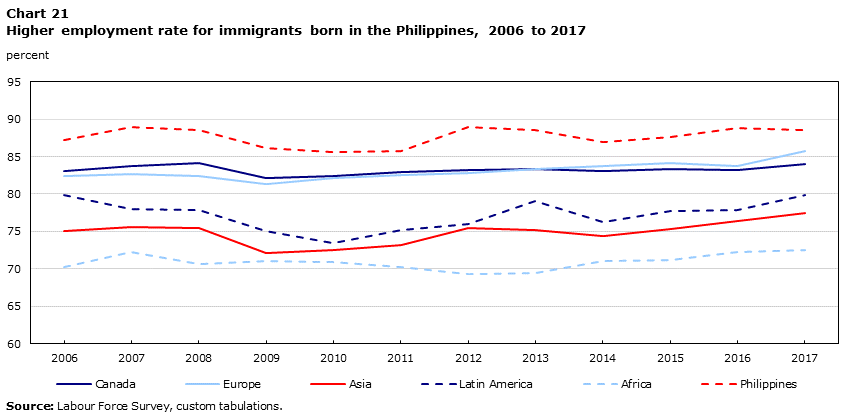
Data table for Chart 21
| Year | Canada | Europe | Asia | Latin America | Africa | Philippines |
|---|---|---|---|---|---|---|
| percent | ||||||
| 2006 | 83.1 | 82.4 | 75.0 | 79.9 | 70.2 | 87.2 |
| 2007 | 83.8 | 82.7 | 75.6 | 78.0 | 72.2 | 88.9 |
| 2008 | 84.1 | 82.4 | 75.5 | 77.8 | 70.6 | 88.5 |
| 2009 | 82.1 | 81.3 | 72.1 | 75.0 | 71.0 | 86.2 |
| 2010 | 82.4 | 82.2 | 72.5 | 73.4 | 70.9 | 85.6 |
| 2011 | 82.9 | 82.6 | 73.2 | 75.2 | 70.2 | 85.7 |
| 2012 | 83.2 | 82.8 | 75.4 | 76.0 | 69.3 | 88.9 |
| 2013 | 83.3 | 83.3 | 75.2 | 79.0 | 69.5 | 88.6 |
| 2014 | 83.1 | 83.7 | 74.4 | 76.2 | 71.0 | 86.9 |
| 2015 | 83.3 | 84.2 | 75.3 | 77.7 | 71.2 | 87.6 |
| 2016 | 83.2 | 83.8 | 76.4 | 77.9 | 72.3 | 88.8 |
| 2017 | 84.0 | 85.7 | 77.4 | 79.9 | 72.5 | 88.5 |
| Source: Labour Force Survey, custom tabulations. | ||||||
In addition, a higher proportion of immigrants born in the Philippines (close to 60%) are women, a large number of whom come to Canada under the Live-in Caregiver program (Chart 22).
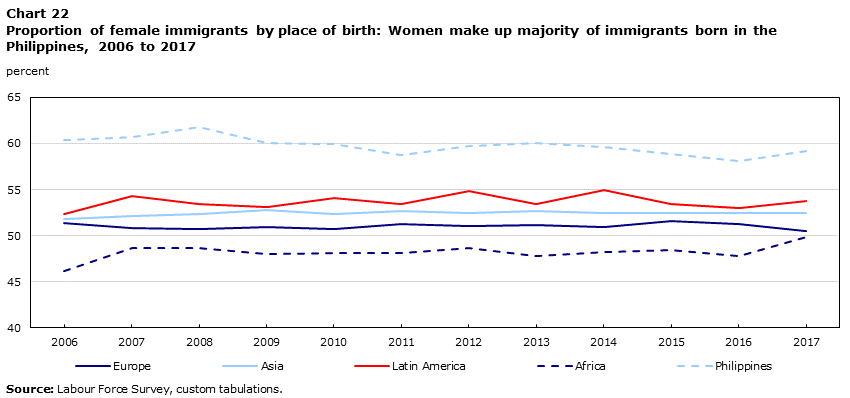
Data table for Chart 22
| Year | Europe | Asia | Latin America | Africa | Philippines |
|---|---|---|---|---|---|
| percent | |||||
| 2006 | 51.4 | 51.8 | 52.3 | 46.2 | 60.4 |
| 2007 | 50.8 | 52.1 | 54.3 | 48.7 | 60.7 |
| 2008 | 50.7 | 52.3 | 53.4 | 48.6 | 61.8 |
| 2009 | 50.9 | 52.8 | 53.1 | 48.0 | 60.1 |
| 2010 | 50.7 | 52.3 | 54.1 | 48.1 | 59.9 |
| 2011 | 51.3 | 52.7 | 53.4 | 48.1 | 58.8 |
| 2012 | 51.0 | 52.4 | 54.8 | 48.6 | 59.7 |
| 2013 | 51.2 | 52.7 | 53.4 | 47.8 | 60.1 |
| 2014 | 50.9 | 52.4 | 54.9 | 48.2 | 59.6 |
| 2015 | 51.6 | 52.5 | 53.4 | 48.4 | 58.9 |
| 2016 | 51.3 | 52.4 | 53.0 | 47.8 | 58.1 |
| 2017 | 50.5 | 52.4 | 53.8 | 49.8 | 59.2 |
| Source: Labour Force Survey, custom tabulations. | |||||
European-born immigrants’ employment rate up
In 2017, European-born immigrants—who have the second highest employment rate after immigrants born in the Philippines—were the only immigrant group with a significant increase in their employment rate, from 83.8% in 2016 to 85.7% in 2017 (Chart 21). This was essentially due to a slight increase (+2.3%) in their employment level combined with no growth in their population. Their unemployment rate stood at 4.6%, similar to the rate of the Canadian-born. Unsurprisingly, immigrants born in Europe have typically had labour-market outcomes similar to the Canadian-born. This may be partly explained by similarities in the education systems and by the fact that English and French are common languages in some parts of Europe.
Employment rate little changed for immigrants born in Asia and Latin America
Over half of Canada’s immigrant labour force was born in Asia: 54% in 2017, up from 45% in 2006 (Chart 23). The majority (about 60%) of these immigrants were born in China (mainland and Hong Kong), India and the Philippines. Although roughly unchanged at 77.4% in 2017 from 2016, the employment rate for Asian-born immigrants was trending upward since 2014. Their unemployment rate also was little changed, at 6.2% in 2017.

Data table for Chart 23
| Year | Europe | Asia | Latin America | Africa |
|---|---|---|---|---|
| percent | ||||
| 2006 | 29.0 | 44.9 | 14.2 | 7.5 |
| 2007 | 28.6 | 46.0 | 13.6 | 7.4 |
| 2008 | 26.9 | 47.5 | 13.2 | 7.8 |
| 2009 | 26.4 | 47.4 | 14.0 | 8.1 |
| 2010 | 26.1 | 48.0 | 13.4 | 8.4 |
| 2011 | 24.7 | 48.1 | 14.2 | 8.8 |
| 2012 | 23.8 | 50.4 | 13.8 | 8.6 |
| 2013 | 23.7 | 49.7 | 13.7 | 9.0 |
| 2014 | 22.4 | 50.8 | 13.3 | 9.8 |
| 2015 | 20.9 | 52.1 | 13.3 | 10.1 |
| 2016 | 19.8 | 54.0 | 13.3 | 9.8 |
| 2017 | 19.7 | 54.5 | 12.1 | 10.4 |
| Source: Table 14-10-0089-01 (formerly CANSIM table 282-0108). | ||||
For immigrants born in Latin America, the employment rate was 79.9% in 2017, little changed from 2016. At the same time, their unemployment rate fell to 6.4% (-2.9 percentage points), following a decline in their labour force—itself a result of a decrease in their population.
Little change in labour-market outcomes for immigrants born in Africa
Immigrants born in Africa make up about 10% of Canada’s immigrant labour force aged 25 to 54. Their overall labour-market conditions were little changed in 2017 compared with the previous year. Their employment rate was 72.5% in 2017, still lower than the rate for the other immigrant groups, though slightly higher than it had been since 2012 (Chart 21 above). Their unemployment rate was also little changed in 2017, at 11.2%, and was higher relative to other immigrants.
Those who are very recent immigrants, in particular, are more likely to face further challenges in the labour market, with an employment rate of 61.3% in 2017—the lowest compared to any other immigrant group. Also, their unemployment rate, at 17.7%, was the highest. The corresponding figures for their established counterparts were 77.1% and 9.4%, respectively.
Data from Immigration, Refugees, and Citizenship Canada (IRCC) show that Africa is one of the source-areas of higher proportions of refugees who are resettled in Canada.Note 16
As was documented in the Longitudinal Survey of Immigrants to Canada,Note 17 refugees are more likely to face a number of challenges in the process of economic and labour-market integration compared with newcomers from other immigrant categories, such as lower employment rates and more language barriers. None have gone through the selection process that economic-class applicants go through, though this does not necessarily mean that their level of qualifications is any different. Also, they do not often have strong family ties in Canada that family-class applicants have. As well, they are less likely to have been prepared for the move to Canada as skilled immigrants are—e.g., they may not have all their belongings, including credentials. In sum, “entering the labour market is a difficult task for most refugees”,Note 18 and it can take decades for them to fully integrate into the Canadian labour market.Note 19
Immigrants’ labour-market outcomes by educational attainment
Immigrants to Canada are more likely to be university-educated than the Canadian-born. In 2017, virtually half (49.6%) of the core-aged immigrant labour force held a university degree versus 30.1% for the Canadian-born in the same age group. The corresponding figures in 2006 were 36.6% and 23.2% respectively.
Between 2016 and 2017, employment among university-educated immigrants rose by 5.4%, driven by full-time work. As a result of this employment increase, the employment rate for university-educated immigrants rose by 1.5 percentage points to 82.1%—the highest level observed during the 12-year period of the data series. At the same time, their unemployment rate edged down to 6.1% (Table 6).
For the Canadian-born with university education, employment in 2017 was slightly up from 2016 (+2.9%). Their employment rate also rose slightly to 91.4%, the highest rate recorded since the start of the immigrant data series in 2006. On the other hand, their unemployment rate edged down to 2.9%.
Among university-educated immigrants, half of the employment growth in 2017 was attributable to those who were established immigrants. Their employment rate was 86.1% in 2017, the highest rate since 2008 (Chart 24).
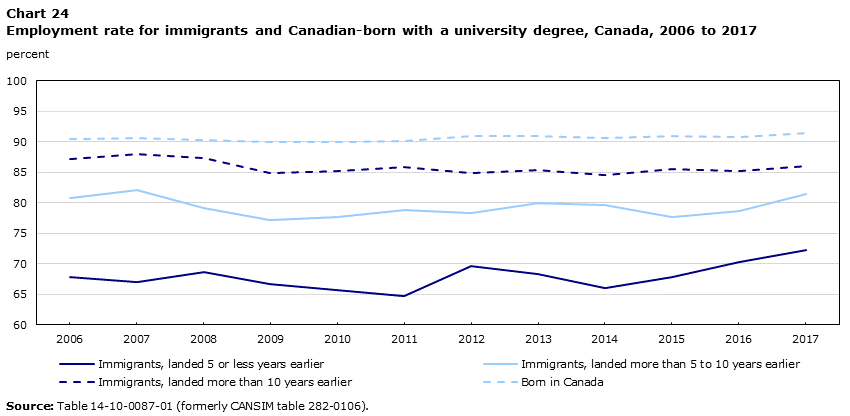
Data table for Chart 24
| Year | Immigrants, landed 5 or less years earlier | Immigrants, landed more than 5 to 10 years earlier | Immigrants, landed more than 10 years earlier | Born in Canada |
|---|---|---|---|---|
| percent | ||||
| 2006 | 67.8 | 80.8 | 87.2 | 90.5 |
| 2007 | 67.1 | 82.1 | 88.0 | 90.7 |
| 2008 | 68.7 | 79.2 | 87.4 | 90.3 |
| 2009 | 66.7 | 77.2 | 84.9 | 89.9 |
| 2010 | 65.7 | 77.7 | 85.3 | 89.9 |
| 2011 | 64.8 | 78.8 | 85.8 | 90.2 |
| 2012 | 69.7 | 78.4 | 84.9 | 90.9 |
| 2013 | 68.3 | 79.9 | 85.4 | 90.9 |
| 2014 | 66.0 | 79.6 | 84.5 | 90.6 |
| 2015 | 67.8 | 77.7 | 85.6 | 90.9 |
| 2016 | 70.3 | 78.7 | 85.2 | 90.8 |
| 2017 | 72.2 | 81.4 | 86.1 | 91.4 |
| Source: Table 14-10-0087-01 (formerly CANSIM table 282-0106). | ||||
In 2017, nearly one-third of employment gains among university-educated immigrants were accounted for by newcomers (in the country for 5 years or less). The increase in employment (+9.2%) for these immigrants boosted their employment rate to 72.2%, the highest level since 2006, and lowered their unemployment rate to 9.7%, below double digits for the first time in 12 years (Table 6).
| Unemployment rate | Employment rate | |||||
|---|---|---|---|---|---|---|
| Landed immigrants | Immigrants, landed 5 or less years earlier | Born in Canada | Landed immigrants | Immigrants, landed 5 or less years earlier | Born in Canada | |
| percent | ||||||
| 2006 | 6.4 | 11.8 | 2.8 | 80.2 | 67.8 | 90.5 |
| 2007 | 5.9 | 10.7 | 2.4 | 80.9 | 67.1 | 90.7 |
| 2008 | 6.5 | 10.8 | 2.8 | 80.1 | 68.7 | 90.3 |
| 2009 | 8.9 | 13.8 | 3.3 | 78.1 | 66.7 | 89.9 |
| 2010 | 8.7 | 14.4 | 3.5 | 78.2 | 65.7 | 89.9 |
| 2011 | 7.6 | 13.1 | 3.3 | 78.8 | 64.8 | 90.2 |
| 2012 | 7.9 | 12.2 | 3.1 | 79.6 | 69.7 | 90.9 |
| 2013 | 7.2 | 11.6 | 2.8 | 79.9 | 68.3 | 90.9 |
| 2014 | 7.2 | 11.9 | 3.0 | 79.1 | 66.0 | 90.6 |
| 2015 | 7.1 | 11.2 | 3.2 | 79.6 | 67.8 | 90.9 |
| 2016 | 6.7 | 10.9 | 3.1 | 80.6 | 70.3 | 90.8 |
| 2017 | 6.1 | 9.7 | 2.9 | 82.1 | 72.2 | 91.4 |
| Source: Table 14-10-0087-01 (formerly CANSIM table 282-0106). | ||||||
Newcomers, in general, make up the group with the largest differentials in labour-market outcomes. They tend to be younger and more likely to hold foreign degrees. They are also more likely to need time to go through the process of foreign credential recognitionNote 20 and adjust to the Canadian labour market.
In 2017, very recent immigrants with a university degree were more likely to be employed in the Western provinces than elsewhere in the country. Their employment rate ranged from 74.1% in British Columbia to 78.8% in Alberta, higher than the Canadian average of 72.2%.
While university-educated newcomers in Quebec continue to have lower rates of employment, they have also seen these rates increase (from 58.8% in 2006 to 67.7% in 2017), and this increase (+8.9 percentage points) boosted the overall national employment rate (+4.4 points) for very recent immigrants with university degrees.
Saskatchewan, British Columbia and Manitoba also contributed to the national increase in the employment rate for university-educated newcomers.
Average weekly wages of core-aged university-educated immigrants
Another key indicator of labour-market outcomes is employment earnings, particularly for workers with university education—given the higher proportion of university-degree holders among immigrants relative to the Canadian-born and Canada’s greater emphasis on selecting skilled and well-educated immigrants.
Similar to other labour-market indicators, wages can also be affected by the length of time spent in Canada as a landed immigrant. For example, established immigrants are the group whose outcomes tend to converge the most with the Canadian-born. Downturns in the business cycle can also affect certain immigrant groups differently than the Canadian-born, as was the case during the 2008-2009 recession for immigrants landed less than 10 years earlier (Chart 25).

Data table for Chart 25
| Year | Immigrants, landed 5 or less years earlier | Immigrants, landed more than 5 to 10 years earlier | Immigrants, landed more than 10 years earlier | Born in Canada |
|---|---|---|---|---|
| dollars | ||||
| 2006 | 716.12 | 881.61 | 1039.93 | 1044.93 |
| 2007 | 738.64 | 903.10 | 1040.96 | 1086.59 |
| 2008 | 788.66 | 943.29 | 1052.24 | 1131.28 |
| 2009 | 780.03 | 905.92 | 1090.39 | 1158.18 |
| 2010 | 740.50 | 895.91 | 1076.03 | 1168.39 |
| 2011 | 777.27 | 931.86 | 1115.52 | 1187.04 |
| 2012 | 797.08 | 961.72 | 1128.80 | 1227.99 |
| 2013 | 812.99 | 960.64 | 1161.13 | 1242.99 |
| 2014 | 839.57 | 958.13 | 1151.98 | 1267.53 |
| 2015 | 865.52 | 958.12 | 1206.92 | 1284.03 |
| 2016 | 893.68 | 980.38 | 1228.34 | 1315.22 |
| 2017 | 925.36 | 1032.26 | 1270.11 | 1326.67 |
| Source: Labour Force Survey, custom tabulations. | ||||
In 2017, the wage-gap between the Canadian-born and immigrants overall narrowed slightly compared with 2016. Wages for very recent immigrants aged 25 to 54 and with a university degree represented 70% of the amount earned by their Canadian-born counterparts in 2017, up from 68% the previous year. The corresponding figure for established immigrants was 96%, up from 93% (Table 7). Compared with 2006, the gap in 2017 was virtually the same, with immigrants’ wages representing 87% of the amount earned by the Canadian-born for both years.
| 2016 | 2017 | 2016 to 2017 | |
|---|---|---|---|
| dollars | percentage change | ||
| Average weekly wages | |||
| Landed immigrants | 1,111.20 | 1,150.40 | 3.5 |
| Immigrants, landed 5 or less years earlier | 893.68 | 925.36 | 3.5 |
| Immigrants, landed more than 5 to 10 years earlier | 980.38 | 1,032.26 | 5.3 |
| Immigrants, landed more than 10 years earlier | 1,228.34 | 1,270.11 | 3.4 |
| Born in Canada | 1,315.22 | 1,326.67 | 0.9 |
| Immigrants to Canadian-born wage ratio | |||
| Landed immigrants | 0.84 | 0.87 | Note ...: not applicable |
| Immigrants, landed 5 or less years earlier | 0.68 | 0.70 | Note ...: not applicable |
| Immigrants, landed more than 5 to 10 years earlier | 0.75 | 0.78 | Note ...: not applicable |
| Immigrants, landed more than 10 years earlier | 0.93 | 0.96 | Note ...: not applicable |
| Born in Canada | Note ...: not applicable | Note ...: not applicable | Note ...: not applicable |
|
... not applicable Source: Labour Force Survey, custom tabulations. |
|||
Summary
In 2017, over a quarter (26%) of Canada’s total workforce of core working-age (25 to 54) were landed immigrants, up from 21% in 2006. At the same time, the corresponding share of Canadian-born workers in the same age group fell from 78% to 72%.
Like other industrialized countries, Canada’s population age-structure has been undergoing changes resulting from increasing life expectancy and falling fertility rates. These long-standing changes are reflected in the country’s continued reliance on immigration to maintain and further its economic growth.
These changes are also reflected in the labour market, as employment growth has been essentially coming from two groups: core-aged immigrants and Canadian-born 55 and older. From 2016 to 2017, employment in the core working-ages of 25 to 54 increased by 2.9% (+87,000) among landed immigrants, while it rose by 0.7% (+59,000) among the Canadian-born. Additional employment gains during 2017 came from the Canadian-born aged 55 and older (+3.8% or +103,000).
The largest share of the immigrant employment increase from 2016 to 2017 was accounted for by those who had been in the country for more than 10 years (established immigrants). However, over one-third (35%) of this increase was attributable to newcomers (in Canada for 5 years or less).
For the first time since 2006 (when comparable data became available), the unemployment rate for core-aged newcomers fell below the double digits: 9.6% in 2017, and their employment rate (69.8%) was at the highest level since 2006.
Gender differentials are particularly notable for immigrant women—irrespective of how long they have been in the country. Their employment rate is significantly lower than the rate for their Canadian-born counterparts. Similarly, their unemployment rate is also significantly higher.
By contrast, the gaps in labour-market outcomes for immigrant men appear to be closing compared to the Canadian-born, with rates of employment and unemployment being similar for both groups.
Appendix
Canada’s population characteristics: Some key facts from the Labour Force Survey
More immigrants
During the 12-year period from 2006 to 2017, Canada’s immigrant population aged 15 and older continued to grow, at an average annual rate of 2.5%, compared to 0.8% for the Canadian-born. This growth is reflected in the share of immigrants within the Canadian populationNote 21 aged 15 years and older, which increased from nearly 22% in 2006 to 25% in 2017 (Table 8).
At the same time, the share of the Canadian-born population 15 years of age and older fell from nearly 76% to almost 73%. Given current demographic trends (for example, population aging, declining birth rate), it is expected that Canada will continue to rely on immigrants for its economic growth.
| 2006 | 2017 | |
|---|---|---|
| thousands | ||
| Total population | 26,115.5 | 29,901.7 |
| Born in Canada | 19,932.3 | 21,723.9 |
| Landed immigrants | 5,730.0 | 7,483.3 |
| Immigrants, landed 5 or less years earlier | 787.9 | 950.5 |
| Immigrants, landed more than 5 to 10 years earlier | 803.0 | 1,052.1 |
| Immigrants, landed more than 10 years earlier | 4,139.1 | 5,480.8 |
| OtherTable 8 Note 1 | 453.2 | 694.5 |
| percent | ||
| Total population, distribution | 100.0 | 100.0 |
| Born in Canada | 76.3 | 72.7 |
| Landed immigrants | 21.9 | 25.0 |
| Immigrants, landed 5 or less years earlier | 3.0 | 3.2 |
| Immigrants, landed more than 5 to 10 years earlier | 3.1 | 3.5 |
| Immigrants, landed more than 10 years earlier | 15.8 | 18.3 |
| OtherTable 8 Note 1 | 1.7 | 2.3 |
Source: Table 14-10-0083-01 (formerly CANSIM table 282-0102). |
||
In 2017, more than half (nearly 53%) of all immigrants were aged 25 to 54, similar to the proportion recorded in 2006 (close to 54%). In contrast, less than half of the Canadian-born (nearly 48%) were of core working-age, down from 54% in 2006 (Chart 26). Because they are more likely to have finished their schooling and less likely to be retired, core-aged individuals are most likely to participate in the labour market. That is why this analysis is largely focused on this age group.

Data table for Chart 26
| 2006 | 2017 | ||
|---|---|---|---|
| percent | |||
| 15 to 24 years | Landed immigrants | 9.2 | 8.3 |
| Born in Canada | 18.6 | 16.2 | |
| 25 to 54 years | Landed immigrants | 53.6 | 52.8 |
| Born in Canada | 54.0 | 47.5 | |
| 55 years and older | Landed immigrants | 37.1 | 39.0 |
| Born in Canada | 27.3 | 36.2 | |
|
|||
Another difference between the age structure of immigrants and that of the Canadian-born is the share of the population aged 55 and older. While this share is relatively higher among immigrants, it has been relatively stable between 2006 and 2017 for this group, edging up by 1.8 percentage points.
In contrast, the share of those 55 years and older among the Canadian-born has risen from about 27% to about 36% between 2006 and 2017. Indeed, this is the only segment of the Canadian-born that has been growing, as the proportions of both youth aged 15 to 24 and the population aged 25 to 54 have been declining throughout the period (-2.4 and -6.5 percentage points respectively).
Ontario and British Columbia: Home to two-thirds of core-aged immigrants
All provinces saw an increase in the number of core-aged immigrants between 2006 and 2017. As in 2006, Ontario and British Columbia had the largest share of immigrants within their core-aged population in 2017.
In Alberta, more than a quarter (nearly 26%) of the total core-aged population were immigrants, up from about 17% in 2006. On the other hand, the largest increase in the share of core-aged immigrants was recorded in Saskatchewan, where their proportion tripled in the 12-year period.
While the Atlantic regionNote 22 had the lowest share of their core-aged population composed of immigrants (about 6%), it was up from about 3% in 2006 (Chart 27).

Data table for Chart 27
| 2006 | 2017 | |
|---|---|---|
| percent | ||
| Ontario | 31.3 | 34.3 |
| British Columbia | 27.9 | 33.0 |
| Canada | 21.8 | 26.9 |
| Alberta | 17.4 | 25.5 |
| Manitoba | 15.3 | 24.3 |
| Quebec | 12.8 | 19.0 |
| Saskatchewan | 5.6 | 16.6 |
| Atlantic regionChart 27 Note 2 | 3.2 | 5.7 |
|
||
Share of immigrants in the metropolitan area of Toronto: Higher, though in decline
Among census metropolitan areas (CMAs), Toronto had the largest share (about 37%) of Canada’s total core-aged immigrant population, although this proportion was down from about 42% in 2006. At the same time, other metropolitan areas such as Montreal, Calgary, Edmonton and, to some extent, Winnipeg, have seen increases in their share of the total core-aged immigrant population (Chart 28).
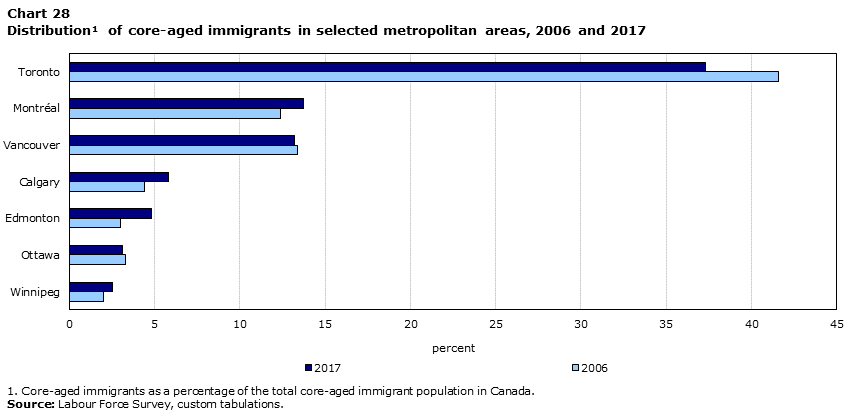
Data table for Chart 28
| 2006 | 2017 | |
|---|---|---|
| percent | ||
| Toronto | 41.6 | 37.3 |
| Montréal | 12.4 | 13.7 |
| Vancouver | 13.4 | 13.2 |
| Calgary | 4.4 | 5.8 |
| Edmonton | 3.0 | 4.8 |
| Ottawa | 3.3 | 3.1 |
| Winnipeg | 2.0 | 2.5 |
|
||
However, while core-aged immigrants are now less concentrated in Toronto, they still make up more than half of its core-aged population: about 54% in 2017, up from 52% in 2006 (Chart 29). Next came Vancouver (nearly 47%), Calgary (close to 33%), and Montréal (31%) with the largest shares of immigrants in their respective core working-age populations.
Winnipeg (about 29%) and Edmonton (about 29%) also ranked among the top 15 metropolitan areas with the largest shares of immigrants in their respective populations. Although they had smaller shares of immigrants, Regina and Saskatoon saw these shares more than double from 2006 to 2017.

Data table for Chart 29
| 2006 | 2017 | |
|---|---|---|
| percent | ||
| Toronto | 52.0 | 54.1 |
| Vancouver | 41.1 | 46.8 |
| Calgary | 24.6 | 32.6 |
| Montréal | 22.7 | 31.0 |
| Winnipeg | 20.0 | 29.1 |
| Edmonton | 19.7 | 29.1 |
| Ottawa–Gatineau, Ontario part | 25.2 | 28.1 |
| Abbotsford–Mission | 25.8 | 28.0 |
| Guelph | 23.4 | 25.8 |
| Ottawa–Gatineau | 21.0 | 25.4 |
| Kitchener–Cambridge–Waterloo | 25.0 | 25.3 |
| Hamilton | 22.5 | 23.0 |
| Windsor | 21.9 | 22.1 |
| Regina | 7.8 | 21.7 |
| Saskatoon | 8.4 | 21.1 |
|
||
- Date modified:
